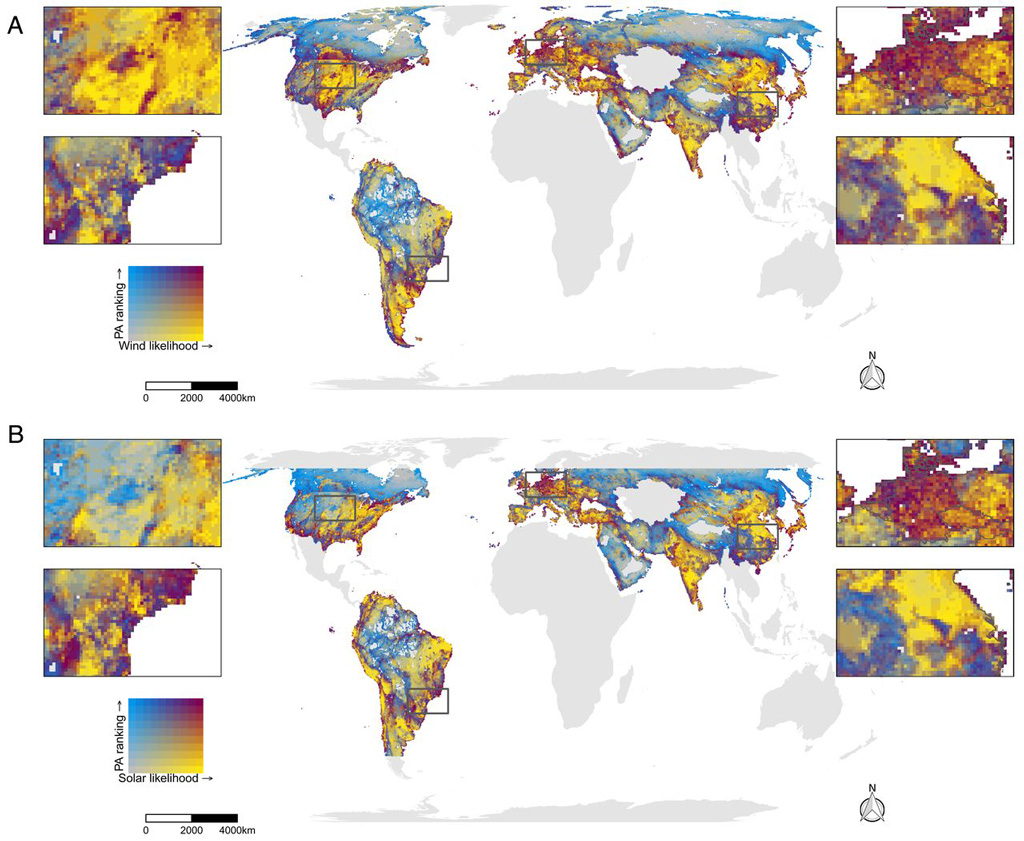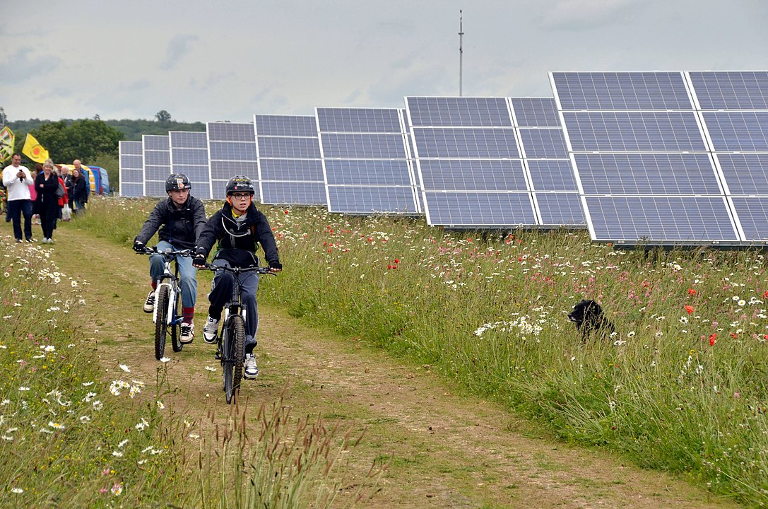The world is facing a climate and ecological crisis. The two planetary crises occasionally pull in the same direction: restoring faltering coastal ecosystems, such as mangroves and saltmarshes, sequester carbon, buffer against more frequent extreme weather events and provide for nature.
However, at other times the crises may seem to antagonise each other: rapid renewable energy expansion is a key part of decarbonising global energy systems, but may take up land precious to the planet’s wildlife.
Indeed, replacing conventional fuels like-for-like with renewable energy could require a global area three orders of magnitude larger than currently used for energy. At the same time, conservationists call for 30% – or even 50% – of the earth to be set aside for nature.
In our new study, published this week in Proceedings of the National Academy of Sciences, we suggest that, while conflicts between renewables and protected areas do occur, overlap need not be as severe as previously suggested, if renewables are deployed with appropriate policy and regulatory controls.
Power struggle
Renewable energy has impacts on biodiversity across its whole lifecycle: from the construction of solar panels, to the operation of hydroelectric, to the eventual decommissioning of wind turbines.
Many of these impacts are well known. As far back as 2015, studies highlighted the worrying overlap of species-rich areas of the world with wind and solar resource potential.
Others documented the mortality of endangered bird species around wind farms, the intrusion of solar and wind installations into protected areas, and even the impact of mining the raw materials used for renewable energy. Other impacts are less well studied.
There is also some evidence for positive impacts: offshore wind farms create de facto protected areas and allow degraded seabed communities space to recover from industrial fishing. There are now guidelines to help developers navigate these potential impacts on biodiversity.
Previous research has already established that a significant number of onshore wind and solar power installations exist in areas important for global biodiversity conservation: areas largely untouched by industrial development, areas protected by law, or areas known to house critical species populations.
Country breakdown
Clearly, enough is known of the impacts of renewable energy to justify limiting their overlap as much as possible. However, it is unrealistic to suggest that land-limited countries could achieve a complete separation of nature and energy.
Our work takes area into account to highlight countries of the world that have either more or less overlap of renewable energy and protected areas than would be expected given land limitations.
Brazil was one country that emerged with more overlap than would be expected, given its large size, and may be a region where stricter land use zoning policies could be targeted.
Surprisingly, our analysis also revealed that for as many as one in eight wind or solar installations that overlap with a protected area worldwide, the protected area was designated after the energy infrastructure was built.
Furthermore, despite concerns that wind and solar in protected areas may require removal of protections or downsizing the area to exclude the energy infrastructure, we found no evidence for this.
Projecting renewable energy expansion
Documenting global solar and wind installations is in its infancy and exacerbated by the lightning deployment speed in some regions. For example, China installed more offshore wind capacity in 2021 alone than the rest of the world had in the preceding five years.
However, the research is growing: in 2020, we produced the first approximation of the global distribution of onshore wind and solar. This was swiftly followed by more detailed datasets for UK solar, offshore wind and, later, global solar.
Our new data allowed us the opportunity to project where renewable energy might be sited in the near future; models we built to do this outperformed previous studies that did not have the luxury of spatially-explicit data.
To see what might happen in the near-term, we combined our projections of renewable energy with a published indicator of an area’s worth to global biodiversity conservation.
The maps below show the results of our projections. The maps show the likelihood of any 30km by 30km cell to contain wind (a) or solar photovoltaic (b) energy versus the importance of the same cell for biodiversity (“PA ranking”).
On the maps, dark purple indicates where biodiversity priorities and wind and solar likelihood are likely to overlap.
Regions of the world in grey did not have enough renewable installations to make accurate predictions.

The likelihood of any 30km by 30km cell to contain wind (a) or solar photovoltaic (b) energy versus the importance of the same cell for biodiversity (“PA ranking”) Source: Dunnett et al. (2022).
To get a feel for how renewable expansion might occur with respect to important conservation areas, we looked at how the most likely 30% of land for renewables in each region overlapped with the most important 30% of land for biodiversity.
The results show that, for the majority of world regions, overlap between renewables and biodiversity were either lower than or as expected, given country land constraints.
Two exceptions are Central Europe and the Middle East, where there is higher than expected overlap between solar expansion and biodiversity areas, and northern Europe, where there is higher than expected overlap between wind expansion and biodiversity.
It is worth noting that, with truly massive expansion of renewables like that required if we were to replace our current energy systems like-for-like, there could be more overlap between energy projects and nature.
This highlights that the journey to decarbonisation would be smoother if it also includes measures to improve energy efficiency and reduce demand.
Overall, our research suggests that with appropriate policy and regulatory controls, we can continue to pursue the crucial climate intervention of transitioning our ailing energy systems while also protecting areas that are rich in biodiversity.
Dunnett, S. et al. (2022) Predicted wind and solar energy expansion has minimal overlap with multiple conservation priorities across global regions, PNAS, https://doi.org/10.1073/pnas.2104764119
Teaser photo credit: By MrRenewablesWestmill Solar Co-operativeBen Cavanna – Own work, CC BY-SA 3.0, https://commons.wikimedia.org/w/index.php?curid=23398808





